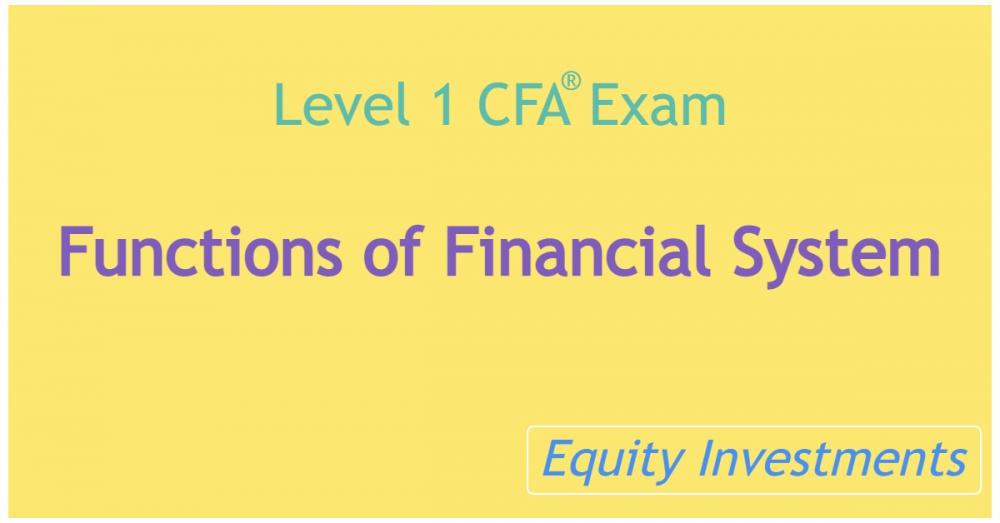Level 1 CFA® Exam:
Functions of Financial System

The financial system consists of financial markets and financial intermediaries. The financial market is a place where capital is moved from entities that hold too much capital to entities suffering from its shortage. Not only capital but also risk and real assets are transferred in the financial market. The transfer of these assets is possible thanks to financial intermediaries.
When the market is functioning properly, transaction costs are low. What’s more, as capital resources are limited, the capital available in the market should be used in the most efficient manner.
Thanks to the financial system many processes are possible and these are:
- saving,
- borrowing,
- raising equity capital by businesses,
- managing risk,
- exchanging assets for immediate delivery, and
- trading on information.
Saving
Saving is refraining from spending money now. In other words, it’s refraining from consumption. The purpose of saving money is not only the desire to use it in the future but also to store it and use it in case of unexpected events. Saving can be defined as moving money from the present to the future.
The saving process is carried out by a variety of entities which have different reasons for doing so. For example, think of a person who refrains from spending money and, thus, moves some of his or her earnings into the future in order to compensate for the lack of remuneration when he or she retires. Also different business entities can save money for instance from sales revenue in order to repay debt or buy new equipment.
Instruments used to save money are:
- certificates of deposit,
- stocks,
- bonds,
- mutual funds, etc.
Thanks to these instruments, you can achieve higher rates of return than in the case of holding cash, which is exposed to inflation. If an entity decides to buy a given instrument in return for invested funds, it expects a rate of return which compensates for the risk involved.
Borrowing
Another process available on the financial market is borrowing. If a company wishes for example to buy equipment or carry out a project, or when a person wants to buy, say, a house or a car, they need capital. It may happen, however, that these entities do not have sufficient capital resources to fulfil their plans. In this case, they may take out a loan. If people need money, they are offered mortgages or credit cards. Companies may issue bonds or use lines of credit.
All of these ways of borrowing are associated with the need to pay compensation to the lender or investor (usually in the form if interest). This compensation mostly takes the form of interest, and its amount depends on the risk involved. The more likely the loss of the borrowed money, the higher the interest paid to the lender.
Raising Equity Capital
Another process of the financial market is raising equity capital. When a company plans to carry out a project and doesn’t have sufficient funds, it can raise money by selling ownership interests.
(...)
Information-Motivated Trading
The financial system also allows for information-motivated trading. Information-motivated trading consists in making investment decisions on the basis of information available to a trader. This information should allow us to predict future price changes of a given financial instrument. Of course, investors who trade on information try to buy undervalued assets because they hope that their prices will increase. On the other hand, if the assets become overvalued, investors sell them.
What is important is the fact that information-motivated traders expect that the return earned using information will be higher than the expected return made by investors who only buy and hold financial instruments.
What distinguishes information-motivated trading from traditional investing are the motives for trading. Traders focused on information seek to make a profit on trade based on forecasts concerning future prices, while ordinary investors want to move wealth from the present to the future. Note that the time period is not the criterion distinguishing these two groups of market participants. Let’s look at an example.
Example 4
There are two entities: a bank and a pension fund. Both entities want to move money forward but the time period is not specified. The bank intends to move money overnight and wants to achieve it by using money market instruments in the interbank funds market. However, the pension fund, because of the function it serves, wants to move it for a dozen or even dozens of years. In this example, even though there are differences in the time horizon, both actions can be considered as traditional investments and not information-motivated trading.
We’ve discussed processes available on the financial system. Now let’s say about the functions of the financial systems. One of the functions is to allow for the processes that we’ve just discussed. Another function is determining rates of return. And finally the financial system serves capital allocation efficiency.
Determining Rates of Return
Let’s now focus on an expected rate of return, which is related to moving money through time. Because entities with excess capital invest in instruments issued by those who raise capital, the money moving forward equals money moving in the opposite direction.
Note that if the expected rate of return on investment goes up in the market, most companies forgo current consumption in order to invest their funds. And vice versa.
The situation is similar in the case of borrowers and issuers. The value of assets moved from the future to the present depends on the cost of borrowing funds or the cost of giving up ownership in the company, respectively. As the total money saved must be equal to the total money borrowed and received in exchange for equity, the expected rate of return depends on aggregate supply of savings and aggregate demand for them. If the expected rate of return is too low, savers will want to move less money forward than borrowers and issuers will want to move to the present. And vice versa.
Note, that there is an interest rate, called the equilibrium interest rate, where the aggregate supply of funds is the same as the aggregate demand for them. One of the functions of the financial system is to discover this interest rate.
Capital Allocation Efficiency
Capital is allocated efficiently if only the best projects get the financing. As a result, not all projects receive funding, but only those with the greatest potential. Capital providers take care of efficiency. They are afraid of losing money so they spend it on more risky projects on condition that they get a higher interest rate. In order to avoid losses and allocate capital efficiently, investors thoroughly analyze different investment opportunities available to them.
- The financial system consists of financial markets and financial intermediaries.
- Processes available on financial system include saving, borrowing, raising equity, managing risk, exchanging assets for immediate delivery and information-motivated trading.
- Saving is refraining from consumption, i.e. spending money now.
- Raising equity capital cannot take place without financial institutions which specialize in such processes, e.g. investment banks.
- Risk management is a process designed to reduce all potential negative consequences of risk.
- Information-motivated trading consists in making investment decisions on the basis of information available to a trader.
- Functions of financial system include allowing for the processes, determining rates of return, serving capital allocation efficiency.
- Capital is allocated efficiently if only the best projects get the financing.


